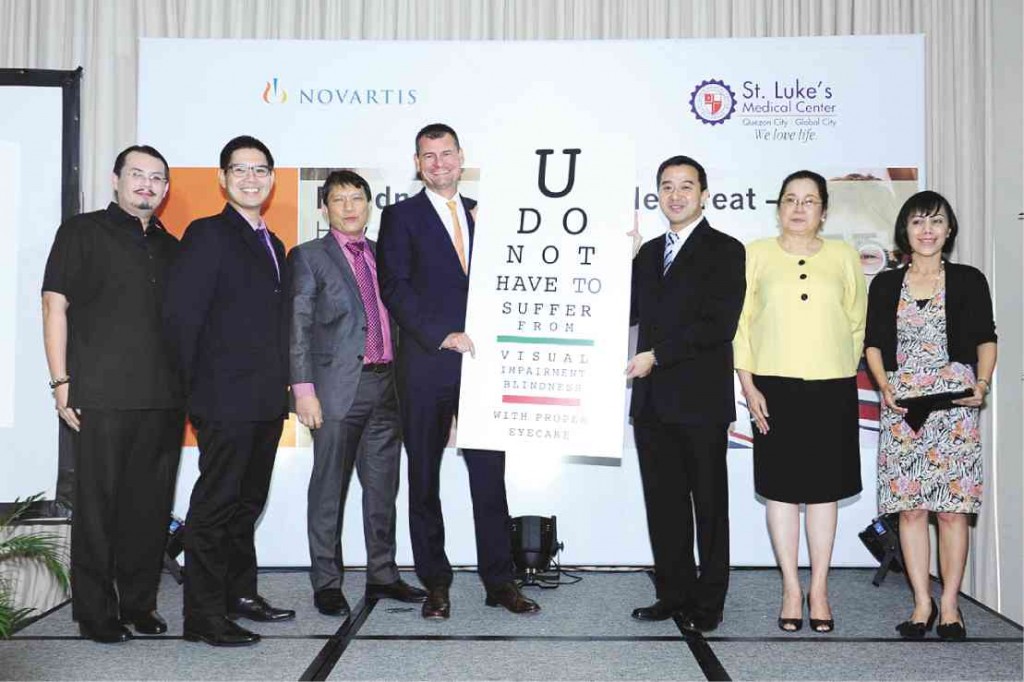
FROM left are Novartis Healthcare Philippines (NHP)-ophthalmology franchise manager Jerome Briones, ophthalmologist Dr. Carlos Emmanoel Chua, St. Luke’s Medical Center (SLMC)-Bonifacio Global City Retina Section head Dr. Albert Mamaril, NHP president and managing director Thomas Weigold, SLMC-Quezon City Eye Institute head Dr. Ruben Lim Bon Siong, SLMC-QC retina section head Dr. Pearl Villalon and NHP corporate affairs and market access head Christine Fajardo.
Three-hundred sixty-five Filipino patients are expected to benefit from effective eye treatments since Novartis Healthcare Philippines partnered with the Eye Institute of St. Luke’s Medical Center (SLMC). The partnership will enhance the diagnosis and treatment of blindness-causing eye diseases.
Top officials of SLMC Eye Institute and Novartis Healthcare Philippines signed the memorandum of agreement (MOA) during a media briefing held recently at the F1 Hotel in Bonifacio Global City, Taguig City.
“Our partnership with the SLMC Eye Institute is in line with our company’s commitment to enhance eye care in the country and promote Filipino patients’ access to effective eye treatments,” Thomas Weigold, country president and managing director of Novartis Healthcare Philippines.
“The Eye Institute, which is renowned for its world-class eye specialists and cutting-edge technology, is pleased to partner anew with global eye care leader Novartis in addressing the eye care needs of Filipino patients,” said Dr. Edgardo Cortez, president and chief executive officer of SLMC.
Under the MOA, Novartis will provide free optical tolerance tomography to 360 qualified patients of the Eye Institute throughout the year starting Jan. 1.
The total number of qualified patients of the Eye Institute will be equally divided between SLMC Quezon City and Global City. There will be 180 patients for each hospital or approximately one patient per day for the whole year. Qualified in the “Patient Assistance Program for OCT Testing” are those currently on the Novartis medication Ranibizumab.
According to SLMC Retina Services section head Dr. Albert Mamaril, Ranibizumab is a prescription medicine used for the treatment of wet age-related macular degeneration, diabetic macular edema, macular edema following retinal vein occlusion and myopic choroidal vascularization in pathologic myopia.
Dr. Pearl Tamesis-Villalon identified the most common retinal disorders. They are age-related macular degeneration (AMD), diabetic retinopathy and macular edema following retinal vein occlusion. AMD, the leading cause of permanent visual impairment among the elderly, is a degenerative retinal disease that can cause central vision loss, leading to legal blindness.
Villalon said diabetic retinopathy is a disorder of the retina in relation to a patient with type 1 or type 2 diabetes with poorly controlled blood sugar levels. It primarily affects the tiny vessels within the retina that leads to fluid leakage and accumulation.
She said retinal vein occlusion is the second most common retinal vascular disorder after diabetic retinopathy. It is a significant cause of visual impairment. CDM

